Delivering Patient Satisfaction at CHI Health
A central kitchen, call center and Convect-Rite III cook-chill system with Safe-Temp help CHI Health provide 2,800 patient meals per day. The facility also serves approximately 1,200 room-service meals daily.
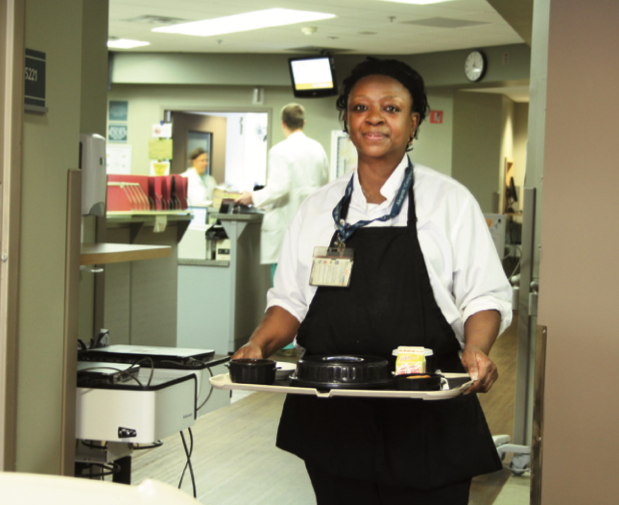

At Creighton University Medical Center, Rosetta Cannon, a catering associate, displays a tray ready for service
In August 2014, Alegent Creighton Health joined other Catholic Health Initiatives hospitals in Nebraska to create CHI Health.
This regional health system in Nebraska and southwest Iowa comprises 15 acute care hospitals, 150 sites of service, two free-standing in-patient psychiatric care facilities, a nationally certified burn center, a nationally certified rehabilitation center and a level 1 trauma center. It employs more than 14,000 people. CHI Health is also the primary teaching partner for Creighton University’s health sciences school. Net revenues total more than $2 billion.
CHI Health is about healthcare organizations coordinating, collaborating and being more effective by working together, while maximizing each organization’s local strengths. By joining together as one, the combined organization gains greater negotiating power with vendors, payers and legislators. Working together reduces costs and improves CHI Health’s quality of care and service to patients across Nebraska and Iowa.
Providing patient meals for CHI Health is the responsibility of a team headed by Senior Director of Food and Nutrition Terri Hill, Director of Central Kitchen and Culinary Kurt Kenkel, Director of Finance Operations Mike Matulka and Clinical Nutrition Director Kristyn Lassek.
Providing patient meals for CHI Health is the responsibility of a team headed by Senior Director of Food and Nutrition Terri Hill, Director of Central Kitchen and Culinary Kurt Kenkel, Director of Finance Operations Mike Matulka and Clinical Nutrition Director Kristyn Lassek.
Together with 21 executive chefs and more than 300 food and nutrition employees, they produce up to 2,800 patient meal trays daily for eight acute care hospitals, as well as other healthcare facilities. Approximately 1,200 room-service trays also are assembled for distribution at five facilities.
“Patients select from a wide variety of menu items printed on restaurant-style menus,” Hill says. Each day, the central diet office staff members located at CHI Health Bergan Mercy receive calls from patients or call patients in their rooms to obtain their meal selections.
Calls are received and made for that day’s lunch between 7:00 a.m. and 9:00 a.m. Calls for that day’s dinner and the next day’s breakfast are received and made between noon and
2:00 p.m. Nurses and family members can also call in to place a patient’s order. Patients who have dietary changes are contacted directly by the central diet staff before meals.
“All patients are visited by catering associates and by a management team associate to ensure patients are getting everything they need,” Hill says. Each day, meal orders are sent from the central diet office to each campus for customization of each tray.
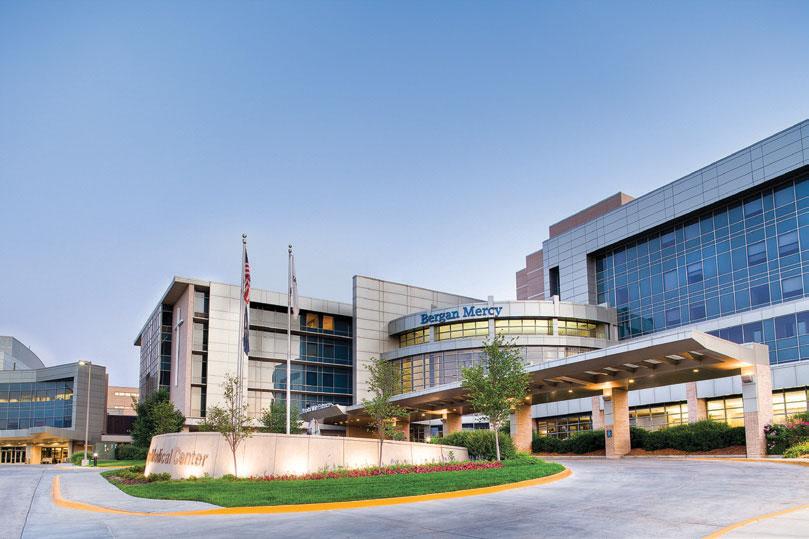

Creighton University Medical Center is one of CHI Health’s 15 acute care hospitals
“The patient food production and delivery system has resulted in outstanding patient satisfaction scores.”
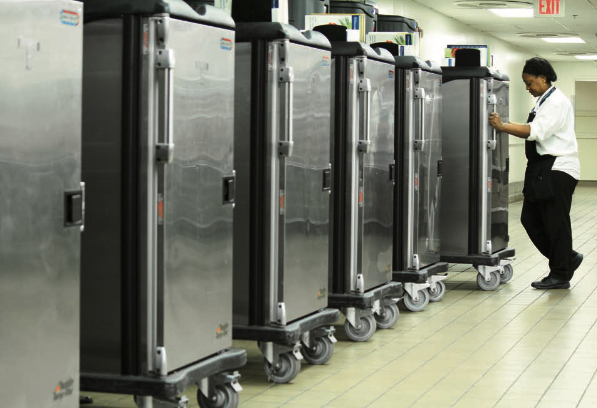

After trays have been customized to match patient orders, Convect-Rite III carts are mated with their docking stations by catering associate Rosetta Cannon
Central Kitchen Production
The central kitchen is the heart of patient food production. Here, sauces, soups, gravies, side dishes and mouth-watering entrées are created using cook-chill equipment that includes kettles, cook tanks, and tumbler chillers. Freshly cooked food is then vacuum packed and rapidly cooled in a tumbler chiller. Production also includes a bake shop overseen by two executive bakers.
On the trayline, staff prepare nine different types of trays that correspond to diet orders. Chilled food is placed on trays that are positioned inside Aladdin Temp-Rite’s 24-tray Convect-Rite III transportation carts. The carts are taken to 26-foot-long refrigerated trucks that deliver them to system hospitals twice a day. Tray carts are stored in refrigerated coolers once they arrive on-site. The farthest transport from the central kitchen is 50 miles away.
About two hours before meals are served on patient floors, trays are removed from tray carts, customized to match patient orders, and replaced. Tray carts are then mated to individual Convect- Rite III docking stations housed in the kitchen. Convect-Rite III can rethermalize up to 30 meals automatically, or manually, at the touch of a button. And many of the bakery products on the menu, such as dinner rolls, are placed on the tray in rough form and cooked inside the Aladdin Convect-Rite III.
The password-protected, programmable docking stations control consistent refrigeration and heat through continuously balanced airflow throughout the cart (hot food typically requires about 50 minutes to heat). Hot food temperatures, as well as cold food temperatures are maintained for 45 minutes after rethermalization.
Because Convect-Rite III can both chill and cook some products many bakery items like biscuits, muffins and cookies are kept cold on trays in raw, dough form and then baked right inside the carts. After rethermalization, the fully insulated Convect-Rite III carts are disengaged from the docking stations to serve as meal delivery carts.
Further safeguarding patient meals, the Safe-Temp wireless monitoring system, part of the Convect-Rite III system, provides real-time cart/docking station temperature monitoring and cart engagement. Information is digitized and wireless technology sends data back to monitoring locations. The self-contained transmitter has a lithium battery for long life and a microprocessor for control. The information is passed via a server data collector.
Training and Follow-Up
Another critical component of the patient tray production and delivery system is intensive employee training. Every associate participates in 28 training modules in which a success rating of at least 90 percent is required. Training includes areas such as patient tray service, transferring trays, understanding central diet office processes and systems, nourishment and tube feedings, and service recovery.
To ensure satisfaction, patient follow-up is also essential. After a catering associate delivers five trays, he or she goes back to the room to see if the patient needs anything further. “We keep this as close to a restaurant-style service as possible,” Hill says.
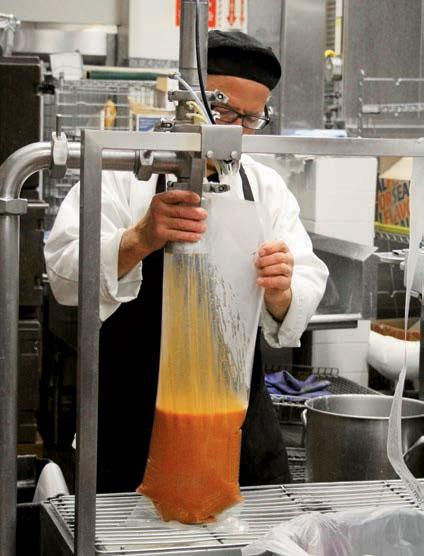

Gene Zurek, a central kitchen cook, prepares food for vacuum packaging before it is placed in a tumbler chiller
“The patient production and delivery system has resulted in outstanding patient satisfaction scores,” Hill says. “Nurses also like this system and the quality of food. And because there are designated times for tray delivery, they can anticipate this and get patients ready to eat.”
Hill says system benchmarking is another crucial element for success. Benchmarking is done annually using the Truven Health Action OI® Operational Performance Improvement Solution tool, which helps facilities evaluate their operational performance in comparison with best-in-class organizations and facilities of similar size, complexity and patient population.
In the future, CHI chefs will be continually developing new menus in order to keep satisfaction scores high. “The ‘chef-centric’ model works to align the chefs’ knowledge of taste and presentation with the dietitians’ focus on nutrition,” Hill says. “And the delivery system drives consistency, which allows the organization to achieve operational and patient satisfaction success.”
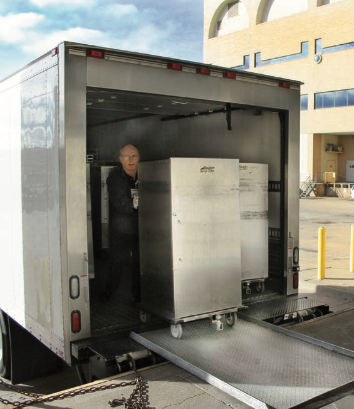

Bob Linton, a truck driver, prepares to transport food from the central kitchen to other foodservice sites in the CHI Health system
Facts of Note
Type of Facility: In August 2014, Alegent Creighton Health joined other Catholic Health Initiatives hospitals in Nebraska to create CHI Health. The regional health system in Nebraska and southwest Iowa brings together 15 acute care hospitals, 150 sites of service, two free standing in-patient psychiatric care facilities, a nationally certified burn center, a nationally certified rehabilitation center and a level 1 trauma center. The organization employs more than 14,000 people. CHI Health is the primary teaching partner for Creighton University’s health sciences school. Net revenues total more than $2 billion.
Beds: 2,820 licensed beds
Average Patient Meals/Day: 2,800 cook-chill meals are prepared daily for eight CHI Health hospitals, in addition to supporting three other local facilities. All use the Aladdin Temp-Rite Convect-Rite III® cook-chill system. In addition, approximately 1,200 room-service meals are provided at five facilities.
Hours of Service: Calls are made to or received from patients for daily lunch orders between 7:00 a.m. and 9:00 a.m. Calls for that day’s dinner and the next day’s breakfast are made to or received from patients between noon and 2:00 p.m.
Menu Specialties: Salmon with teriyaki glaze; breakfast burritos; roasted turkey; bacon, egg and cheese croissants.
Food and Nutrition Staff: More than 300 employees, including a team of 21 executive chefs
Equipment Investment: $3 million Website: www.chihealth.com
KEY PLAYERS
Owners: CHI Health
President, Creighton University Medical Center: Kevin Nokels
Senior Director, Food and Nutrition: Terri Hill
Director of Central Kitchen and Culinary: Kurt Kenkel
Director of Finance Operations: Mike Matulka
Clinical Nutrition Director: Kristyn Lassek
Aladdin Temp-Rite Representatives: Michael Hils and Jeff Withers
